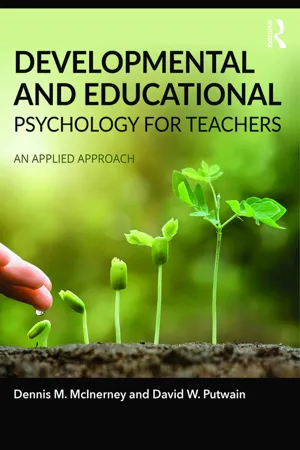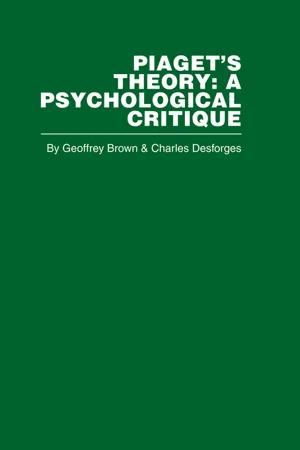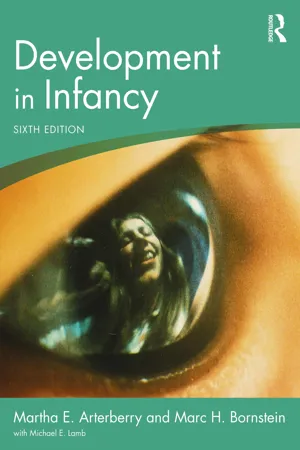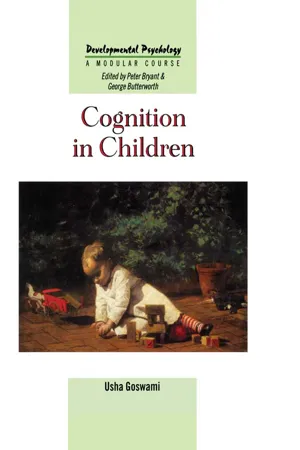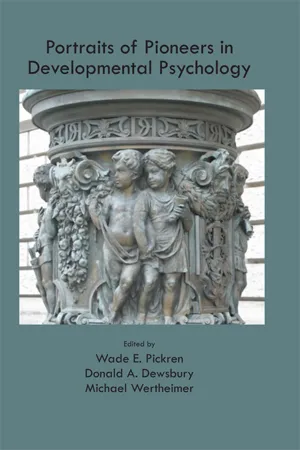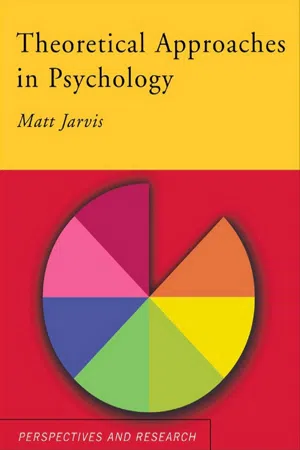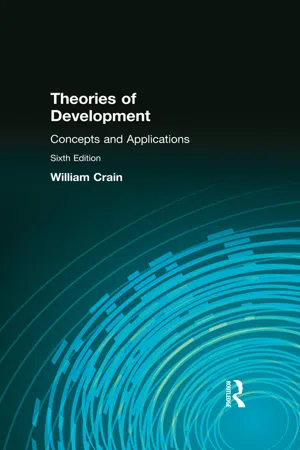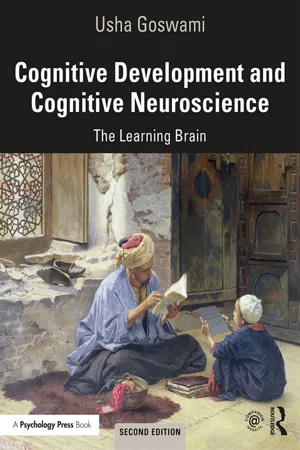Psychology
Piaget Theory of Cognitive Development
Piaget's Theory of Cognitive Development outlines how children's thinking evolves as they grow. It is divided into four stages: sensorimotor, preoperational, concrete operational, and formal operational. Piaget emphasized the importance of children's active participation in learning and the role of their environment in shaping their cognitive development.
Written by Perlego with AI-assistance
Related key terms
11 Key excerpts on "Piaget Theory of Cognitive Development"
- eBook - ePub
Developmental and Educational Psychology for Teachers
An applied approach
- Dennis McInerney, David Putwain(Authors)
- 2016(Publication Date)
- Routledge(Publisher)
Chapter 6 , we look at elements relevant to adolescent education and the educational implications of Piaget and Vygotsky more broadly. We also consider some contemporary views of cognition. Both of these chapters should be read as a unit.Jean PiagetJean Piaget (1896–1980) was a psychologist who has had a profound impact on the way teachers and other professionals think about children (Bibace, 2013). Piaget’s background included training as a biologist, and working with Theophile Simon in the Binet Laboratory in Paris. With Alfred Binet, Simon had earlier constructed the first intelligence test. Both of these experiences had an impact on the development of Piaget’s theory of cognitive development. His theory has two key dimensions. First, Piaget emphasises that intellectual development occurs through a series of stages characterised by qualitatively discrete cognitive structures. Second, Piaget emphasises the notion that children construct their own understandings through interaction with their environment. Piaget viewed the child as a young scientist, constructing ever more powerful theories of the world, as a result of applying a set of logical structures in increasing generality and power (Inagaki & Hatano, 2006). As such his theory has dual and complementary perspectives that may be termed structuralism and constructivism (Fosnot, 2013; Morra et al., 2012).Biological model of cognitive developmentPiaget’s theory is complex. Our description highlights important elements for your consideration, but in doing so we run the risk of oversimplification. Piaget, as a biologist, was impressed by the way in which all species systematically organise their biological processes into coherent systems and are able to adapt, as necessary, to the environment through processes such as assimilation and accommodation - eBook - ePub
- Geoffrey Brown, Charles Desforges(Authors)
- 2013(Publication Date)
- Routledge(Publisher)
Chapter 2 Piaget's theory of cognitive developmentIn this chapter we provide a résumé of Piaget's theory as a framework for subsequent commentary. Illustrative material abounds in Piaget's own writings and in the work of his best-known expositors (e.g. Flavell, 1963 ). In the interests of brevity it will be omitted from these pages.An ideal theory of cognitive development must offer descriptions of mental contents at various points in the development sequence. These descriptions will represent all the rules and knowledge necessary to fulfil the performance characteristics of the organism. The descriptions will be of the underlying competence of the organism (Chomsky, 1972 ; Flavell andWohlwill, 1969 ). To explain particular behavioural acts or performances an ideal theory must also offer a set of rules describing how underlying competence is made manifest and the kinds of organismic and task variables which would elicit or impede performance. Finally, the theory must offer an account of how developmental change comes about. In this chapter we look in detail at Piaget's theory with the above requirements in mind. We present Piaget's view without critical comment. It is our intention to focus key issues here and explore them more fully in subsequent chapters.Piaget sees psychological development as analogous to biological epigenesis (Piaget, 1970a , 1971a ). A few remarks on this process may help an understanding of Piaget's theory. There appear to be four features essential to epigenesis (Kitchener, 1978 ). First, the process involves a causal sequence of events. In a sequence of steps S 1 , S 2 . . . S n , S 1 causes S 2 , S 2 causes S 3 and so on. Second the sequence involves increasing differentiation, complexity and organisation. There is a transformation from homogeneous to heterogeneous 22 states and from general to specific functions. Also, 'the theory of epigenesis, whatever else it may imply, asserts that development is not simply a question of increase of scale . . . but a process in which a genuine increase in "complexity" is progressively achieved' (Woodger, quoted in Kitchener, 1978 - eBook - ePub
- Martha E. Arterberry, Marc H. Bornstein(Authors)
- 2023(Publication Date)
- Routledge(Publisher)
sensorimotor period . It is followed, in the Piagetian system, by preoperational, concrete operational, and formal operational periods through childhood and adolescence. Within the sensorimotor period of infancy, Piaget detailed an additional stage-wise sequence of development.KEY TERMSSensorimotor periodthe stage which encompasses infancy in Piaget’s theoryIn the Piagetian system, observed behaviors reflect an underlying structure, and behaviors related to each stage are thought to emerge in relative synchrony with one another, thereby giving evidence of a stage as a whole. Thus, children’s thoughts at any one time are believed to be coherent, making for a particular view of the world. Importantly, children’s current stage defines the way they view the world and process information in it.When formulating his theory of infant cognitive development, Piaget stressed infants’ moving away from relatively self-focused (which he called egocentrism ) to relatively world-focused ways of thinking. That is, schemes change—cognition develops—to match the real world more and more closely. Piaget described this process in six sub-stages during infancy. These stages follow a progression, and they are roughly age-related. Piaget’s stages also provide evidence of the gradual realization that objects in the outside world are related to one another, at first when they are physically present and subsequently when they are representations in the mind.KEY TERMSEgocentrisminfants’ understanding of the world in terms of their own motor activity, and their inability to understand it from any other perspectiveStage 1: Reflexive Schemes (Birth to 1 Month)
At this stage, infants accommodate very little to environmental stimuli, and they extract little or no information about the outside world. Thus, mental development is minimal and very slow. Piaget believed that infants in Stage 1 cannot recognize that stimuli belong to solid objects in the outside world because different schemes appear uncoordinated (i.e., independent of one another). Because the information processed by one scheme cannot be shifted into or processed by another scheme, infants do not know that a sound and a sight relate to the same object (contrary to recent research discussed in Chapter 6 - eBook - ePub
- Usha Goswami(Author)
- 2014(Publication Date)
- Psychology Press(Publisher)
Piaget’s theory of logical development 8 Piaget’s theory of logical development in childhood has been a seminal one. He was the first developmental psychologist to provide a comprehensive theory of child development covering birth to adolescence, and many of the topics that are central to our understanding of children’s cognition were first investigated by Piaget. This is true of most of the topics included in this book, such as cognition in infancy, causal reasoning, categorisation, and logic. This chapter will provide a brief outline of the major aspects of Piaget’s theory (more detailed treatments can be found in Beilin & Pufall, 1992; Butterworth & Harris, 1994; Chapman, 1988; Gallagher & Reid, 1981; and Inhelder, de Caprona & Cornu-Wells, 1987; to name just a few). We will then assess key aspects of the theory in the light of some of the recent evidence about children’s cognition presented in this book. From J.J. Ducret (1990) Jean Piaget: Biographie et Parcours Intellectual, published by Editions Dalachaux et Niestlé, Lausanne. Overview of the theory The mechanisms of cognitive change Piaget was originally a biologist. This led him to translate the notion that organisms adapt themselves to their environments to the study of children’s thinking. Piaget’s fundamental interest was in the origins of knowledge, just as biologists are interested in the origins of life. He suggested that cognitive development was caused by two processes. These were accommodation and assimilation. Accommodation is the process of adapting cognitive schemes for viewing the world (general concepts) to fit reality. Assimilation is the complementary process of interpreting experience (individual instances of general concepts) in terms of current cognitive schemes. The goal of the organism is cognitive equilibrium. However, as every cognitive equilibrium is only partial, every existing equilibrium must evolve towards a higher form of equilibrium—towards a more adequate form of knowing - eBook - ePub
Portraits of Pioneers in Psychology
Volume III
- Michael Wertheimer, Gregory A. Kimble(Authors)
- 2013(Publication Date)
- Psychology Press(Publisher)
From 1921 until his death, Piaget was engaged in studying child psychology: the development of logic, causal reasoning, and thought; the growth of moral development; the child’s conception of the world; and the emergence of intelligence during infancy and early childhood. This work led to the evolution of his theory of intelligence and its development. During the 1920s and 1930s, this work was highly regarded in the United States. However, during the 1940s and 1950s, the period when psychology was dominated by the philosophy of logical positivism, it met with criticism. Subsequently, as Piaget’s later work appeared in English translation, interest in his work grew once again.Piaget remained an active scientist well into his 80s, revising his theoretical formulations throughout his entire career. He noted that he had provided only a rough sketch of human cognitive development and that later research would provide the parts that were lacking or that needed to be modified or abandoned. Today psychologists debate the merits of Piaget’s work even as they continue to respect his contributions to methodology and to an overarching theory of intellectual development. After a brief overview of the principle components of Piaget’s theory, this chapter discusses some of the controversial elements of his conceptual framework.Major Principles of Piaget’s TheoryPerhaps Piaget’s most significant contribution was to demonstrate the fundamental differences between the intellectual functioning of children and that of adults. At birth, infants are not conscious of themselves or objects as independent structures. From this primitive level, children’s cognitive systems change to become more adaptive and to provide a more realistic understanding of the world. Central to Piaget’s theory is the view that knowledge of the world is not simply an internalized replica of what is external to the self. Rather, acquisition of knowledge is a creative event that depends on and is limited by the cognitive processes that the child has developed. For example, a 2-month-old baby has only a few ways of knowing—by sucking, by touching, and by focusing on round, facelike objects. The infant’s understanding of the world cannot go beyond what is provided by these first cognitive resources. - Wade Pickren, Donald A. Dewsbury, Michael Wertheimer(Authors)
- 2012(Publication Date)
- Psychology Press(Publisher)
6Jean Piaget:Theorist of the Child’s Mind
BERNARD C. BEINSIthaca CollegeJean Piaget (b. August 9, 1896, d. September 16, 1980) has had more influence on the study of cognitive development than any other psychologist. As soon as his first books appeared, psychologists recognized the fertility of his ideas, even though those ideas had to make a linguistic journey from French to English, a translatlantic journey from Switzerland to the United States, and a methodological journey from more philosophical to more psychological. Piaget’s theory of cognitive development continues to dominate developmental psychology over 80 years after its introduction.Figure 6.1 Jean Piaget. (Courtesy of the Jean Piaget Society. With permission.)Piaget’s background mirrored that of the earliest generation of psychologists in his combined focus on the natural sciences and philosophy. Piaget credited his early work in the natural sciences with keeping his focus scientific, but he also maintained a European flavor to his ideas with a greater attachment to philosophy and logic than was common among psychologists in English-speaking countries at the time.Even with the shared background, however, Piaget developed his ideas largely independently of mainstream experimental psychology of the 1920s, which was already being led by English-speaking, behaviorally oriented psychologists in the United States. Piaget’s empirical approach was called “clinical,” relying on small samples and attention to children’s verbal statements to provide insights into cognitive processes. This approach was at variance with American psychology in that the latter had moved away from the study of mental processes that featured so prominently in Piaget’s work. In addition, whereas Piaget tended to study small numbers of children, American psychology had moved toward studying groups, averaging out the effect of unusual behaviors that might have been of great interest to Piaget. The few structuralists of Edward Bradford Titchener’s bent who remained active in psychology in Piaget’s early years would not have studied children because of the children’s relatively limited verbal skills. Their inability to report their introspections would have ruled them out as experimental participants.- eBook - ePub
- Matt Jarvis(Author)
- 2005(Publication Date)
- Routledge(Publisher)
qualitatively different—i.e. children simply do not think in the same way as adults.This idea was extremely radical when Piaget started out, but it has now become generally accepted in cognitive-developmental psychology. In fact you may regard this as common sense. Piaget was interested both in how children learnt and in how they thought. We can have a look at these issues.How children learn
Piaget saw intellectual development as a process in which we construct an internal model of reality. In order to gain the information to construct this internal representation of the world we spend much of our childhood actively exploring ourselves and the outside world. You may have noticed that even very young children are inquisitive about their own abilities and about their surroundings. Piaget proposed that the child’s mental world contains two types of structure, schemas and operations.Schemas
Schemas are packets of information, each of which relates to one aspect of the world, including objects, actions and abstract concepts. Piaget believed that we are born with a few innate schemas which enable us to interact with others. During the first year of life we construct other schemas. An important early schema is the ‘me-schema’ which develops as the child realises during its first few months that it is a separate object from the surrounding world.When a child’s existing schemas are capable of explaining what it can perceive around it, it is said to be in a state of equilibrium. However, whenever the child meets a new situation that cannot be explained by its existing schemas it experiences the unpleasant sensation of disequilibrium. We are all instinctively driven to gain an understanding of the world and so escape disequilibrium. Piaget identified two processes by which equilibration takes place: assimilation and accommodation. - eBook - ePub
Understanding Child Development
Psychological Perspectives and Applications
- Sara Meadows(Author)
- 2017(Publication Date)
- Routledge(Publisher)
Chapter 4 Big Developmental Theories: Piaget, Information-Processing, VygotskyA child discovers number conservation■ Cognitive Development: Piaget, Information-Processing and Vygotsky☐ Piagetian Theory☐ Causes of Cognitive Development☐ Equilibration◯ Stages■ Information-Processing Approaches☐ Capacity, Processes and Knowledge☐ Representations◯ Inhibition and Flexibility☐ Rules, Algorithms and Efficiency◯ Developmental Mechanisms■ Cognition and its Social Construction☐ Language and Thought☐ The ‘Zone of Proximal Development’☐ Cognitive Development is Socio-CulturalDevelopmental psychology has been shifted on its base a few times when major theories appeared that made their precursors look seriously inadequate. In this chapter, I address some of these discipline-shaking theories which apply primarily to the study of cognitive development: Piaget, Information-processing and Vygotsky. Attachment theory, as important, or more so, for understanding socioemotional development, is discussed in later chapters.Cognitive Development: Piaget, Information-Processing and Vygotsky
Studying cognitive development, we are concerned with ‘the child as knower’; with someone who thinks, understands, learns, remembers, reasons and so forth. Accounting for cognitive development involves describing what develops, that is, noting what changes (or continues) between different ages, and explaining how these changes (or continuities) come about. I am going to discuss three dominant paradigms here.PiagetAn anecdote which Piaget used many times gives a good picture of the Piagetian child. A boy aged 5 was playing with his collection of pebbles. He laid them out in a line and counted them along the line from le to right: there were ten. Then he counted them from right to le, and ‘to his great astonishment’ the total was, again, ten. He put them in a circle and counted them first clockwise and then counter-clockwise: ‘full of enthusiasm’ he discovered that there were always ten, that the sum of objects was the same whatever order they were counted in. This child grew up to be a professional mathematician, attributing his choice of career to this experience at age 5. It had been an excitement and a delight to achieve a new cognitive control in the world by putting the pebbles in order, comparing that order with the pre-existing order of numerals from one to ten, and so creating a property of the collection, their numerosity of ten, which was evident only through this activity. - eBook - ePub
- Ernst von Glasersfeld(Author)
- 2013(Publication Date)
- Routledge(Publisher)
Chapter 3Piaget’s Constructivist Theory of KnowingIt is a difficult task to glean a coherent theory of cognitive development from Piaget’s enormous body of work. Over a period of seventy years, Piaget published eighty-eight books, hundreds of articles, and edited countless reports of research that had been carried out under his supervision.1 His thinking and his ideas never ceased to develop, to branch out, and to spiral into new formulations which, in his mind, continuously expanded and modified what he had expressed in earlier writings. As a result, it requires considerable effort to sort out what seems to have remained the same and what was modified in the course of those decades. Those who venture to summarize Piaget’s ideas on the basis of two or three of his books have a limited perspective. They inevitably remain unaware of implications that cannot be grasped except from other parts of his work. Unfortunately, there are countless psychology textbooks and critical journal articles that fail in this respect. At best they provide an incomplete view of Piaget’s theory, at worst they perpetuate distortions of his key concepts. Many summarizers and critics, moreover, seem to have missed, or simply disregarded, the revolutionary approach to epistemology that Piaget developed as the basis of his investigations. This second failing is the more serious. Without the understanding that Piaget quite deliberately stepped out of the western philosophical tradition, it is impossible to come to a comprehensive view of his theory of knowing and the model he built to explain how children acquire knowledge.Piaget is not easy reading. Although he never ceased to praise the virtue of ‘decentration’ — the ability to shift one’s perspective —, he himself, as a writer, did not always try to put himself into his reader’s shoes. I feel that writing often was for him, as for many original thinkers, part of working out his ideas for himself. His untiring efforts to express his thoughts in the greatest possible detail do not always help the reader’s understanding. Yet, I never doubted that it was worth trying to overcome those difficulties, for the effort has led me to a view of human knowing that no other source could have provided. - eBook - ePub
Theories of Development
Concepts and Applications
- William Crain(Author)
- 2015(Publication Date)
- Routledge(Publisher)
Similarly, Tulkin and Konner (1973) suggest that adults in small tribal societies might fail to demonstrate formal operations on Piagetian tasks of mathematical and scientific reasoning, but they employ them when working on problems of vital importance to them. For example, when the indigenous people of the Kalahari discuss animal tracking, they advance and weigh hypotheses in ways “that tax the best inferential and analytic capacities of the human mind” (p. 35).Piaget conceded, then, that at the highest stages people will not demonstrate a great deal of consistency across intellectual tasks—certainly not the same degree of consistency that we expect at the earlier stages. Instead, people employ the highest stages of thinking primarily in their areas of strongest interest.Do Children Really Learn on Their Own?
Perhaps Piaget’s most controversial claim is that cognitive development is a spontaneous process. Children, he said, develop cognitive structures on their own, without direct teaching from adults. The most incontestable evidence for spontaneous learning comes from Piaget’s observations on infants, who make enormous intellectual progress simply by exploring the environment, before anyone takes the trouble to educate them. Once we begin teaching, in fact, we often seem to stifle the child’s natural curiosity. In school, children become disinterested, lazy, rebellious, and frightened of failure. The major task of education, it would seem, would be to liberate the bold curiosity with which children enter life.When Piaget said children learn on their own, he did not mean they learn in a vacuum. Other children can stimulate and challenge the child’s thinking, and it would seem that adults can do the same. As we have seen, Kamii asks children stimulating questions that start them thinking. But Piaget did not believe it is productive to try to teach children right answers or procedures. Instead, real learning comes from experiences that arouse children’s curiosity and give them opportunities to work out their solutions on their own.But many psychologists, particularly American psychologists in the learning-theory tradition, believe adult teaching is more important than Piaget thought. To demonstrate this, they have devised a number of “training studies,” most of which have tried to teach conservation to 4- and 5-year-olds. - eBook - ePub
Cognitive Development and Cognitive Neuroscience
The Learning Brain
- Usha Goswami(Author)
- 2019(Publication Date)
- Routledge(Publisher)
6 ). Although the INRC grouping chosen by Piaget may not have been the appropriate mathematical model for cognition, future advances in cognitive neuroscience seem likely to depend on advances in mathematical theories. Deep learning provides a good example. Modern mathematics has enabled computational models that use multiple processing layers simultaneously to learn from natural data in their raw form (e.g., visual scenes) and models that automatically discover representations at multiple levels of abstraction (LeCun et al., 2015). To date, these models have not been applied to problems in developmental psychology, Further, reverse-engineering the models to discover exactly what is being learned is technically challenging. Nevertheless, deep learning models offer enormous promise for testing developmental theories.Vygotsky’s theory
The notion that developmental changes in reasoning might be better explained by cognitive factors such as familiarity, context, metacognition and language fits well with the theoretical emphasis of Vygotsky’s theory of cognitive development. Vygotsky recognised the importance of language and of cultural context in cognitive development. Although he did not live long enough to generate the wealth of experimental data contributed by Piaget, his ideas about cognitive development were of comparable importance. Whereas Piaget focused on how the individual child constructed knowledge for him- or herself, Vygotsky argued that knowledge originated in socially meaningful activity and was shaped by language. Social context and culture were crucial in explaining cognitive development, and language played an essential role in the organisation of ‘higher psychological functions’ (Vygotsky, 1978, p. 23). Language was seen as the primary symbolic system that children could respond to psychologically. Language hence mediated cognition. Vygotsky argued that cognition developed prior to language, as demonstrated by the cognitive activities of babies. However, “the most significant moment in the course of intellectual development… occurs when speech and practical activity, two previously completely independent lines of development, converge” (p. 24). This convergence was marked by egocentric or private speech, which Vygotsky interpreted as fundamental in organising the child’s cognitive activities. Egocentric speech was seen as part of goal-directed behaviour. Eventually, children were thought to internalise egocentric speech as the ‘inner speech’ that organised mental life.
Index pages curate the most relevant extracts from our library of academic textbooks. They’ve been created using an in-house natural language model (NLM), each adding context and meaning to key research topics.
